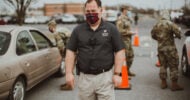The summer of 1979 is permanently etched into my memory. I walked into the intensive care unit as a newly minted intern. I walked over to ICU-Bed 1 to be introduced to my first patient, a frail teenaged boy who was tethered to a ventilator.
“He is day 30 with respiratory failure from disseminated coccidioidomycosis,” my internal medicine resident informed me. “He is your responsibility now, and don’t f*** it up.”
An impending wave of anxiety enveloped me as I visually tracked the unending array of IVs, feeding tube, central line, temporary pacemaker leads, and monitoring equipment surrounding his bed. Over the next six weeks, I quickly learned that I was a small cog in the care that navigated his course away from almost certain mortality. As the credits to a movie may roll for minutes with names that do not have an apparent effect on the finished product, so too is the list of people who render care to the ICU patient. The pulmonologist, critical care specialist, critical care nurses, respiratory therapists, and anesthesiologists represent a core team. Integral to their support are those that are in the supply chain providing meds, equipment (lines, pacemakers, intubation equipment, personal protective equipment, monitors, ventilators) and those that support and repair these items.
Additionally, consultative services such as cardiology, infectious disease, gastroenterology, neurology, hematology, surgery, and ENT, to name a few, are involved with medical and surgical issues that arise from the prolonged hospital course and many complications that arise in patients that cannot provide critical organ function.
Furthermore, ICU patients consume intensive utilization of laboratory and radiology service. Ethics committee members may be involved in deciding end of life and medical futility issues. Family adjustment and bereavement may also need social work and psychiatric services to cope with these psychosocial issues. The workday of the ICU is punctuated by “crisis moments” as each patient may have a life-threatening arrhythmia, mucous plug in a large airway preventing oxygenation, massive gastrointestinal bleed, pneumothorax from high ventilator pressures to name a few of the “falling dominoes” of the critically ill patient.
Universal precaution implementation is, in an ideal world, best adopted in a slow, compliant fashion with a critical care or scrub nurse equivalent monitoring the provider for breaches in technique while putting on and removing personal protective equipment. In real life, emergent events require rushed donning of masks and gowns with possible gaps in the mechanical barriers. Of course, infective risks are greater with the lack of N95 respirators and the use of less protective surgical masks. Now, let’s look at the public risks of community exposure when the family equation is factored in. At least a dozen or more providers may enter an ICU bed in a given day. Most of the health care professionals are young, have families, and extended families that they interface with on a daily basis. A four-person household with a dozen personnel exposed to COVID-19 and a national number of 85,000 ICU beds creates a potential exponential source of infection in the community.
More masks, more providers, and infrastructure are needed now. Can this be possible? Innovation in equipment, medical therapy, and health care delivery are possible given the resiliency of Americans devoted to the well being of the United States. Is it possible? I have faith that this can be overcome. And, yes, my teenage patient in 1979, after 30 more days in the ICU, walked out of the hospital with a smile on his face and his health intact.
Lawrence Hurwitz is a gastroenterologist.
Image credit: Shutterstock.com




















![Preventing physician burnout before it begins in med school [PODCAST]](https://kevinmd.com/wp-content/uploads/The-Podcast-by-KevinMD-WideScreen-3000-px-4-190x100.jpg)



![Why high-quality embryos sometimes fail to implant [PODCAST]](https://kevinmd.com/wp-content/uploads/Design-3-190x100.jpg)
